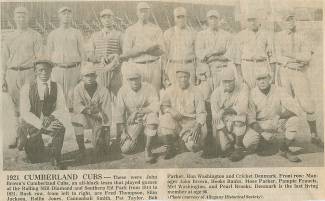Collection Name
About
John Brown's 1921 Cumberland Cubs remembered
By MIKE MASTRANGELO
Special to the Times-News
For a half century, our national pastime excluded black athletes from its fraternity. These black (base) ball players endured segregation and pursued the game they loved by establishing their own formal leagues and independent teams. They barnstormed against one another; and when their summer season was over in the United States, they traveled to Cuba, Mexico and South America to play in the more socially tolerant Latin American countries.
Numerous all-Negro teams grew up all over the country. Teams like the Chicago American Giants, the Homestead Grays and the Kansas City Monarchs would become black ball legends.
Cumberland joined the early list of teams where black baseball was played. Alternately known as John Brown's Cubs or the Cumberland Cubs, the team took its name from their non-playing manager John Brown. The Cubs played at the Rolling Mill Diamond and South End Park from 1914 through 1921. The players did not get much pay, nor was there even a steady payday. Typical of so many other Negro baseball players, these men simply enjoyed playing the game they loved.
The Cubs played some of the popular Negro teams along the east coast, including the Homestead Grays, Baltimore Black Sox, Harrisburg Giants and the Pittsburgh Orioles. They also traveled on a limited basis primarily to Baltimore, Pittsburgh and sometimes to Philadelphia.
Typically, newspapers did not give a great deal of detailed coverage to local black teams. However, in Cumberland, the Cubs received good local coverage, and fan attention, expeciallyinl921.
On July 3, John Brown's Cubs defeated a team from Mount Savage with their pitcher, Beall, hurling a no-hitter. Two weeks later, the Cubs won their eighth straight victory against the Tigers in Hagerstown 7-3.
On July 26, Bullet Smith beat the Frostburg Feds 5-3. Smith pitched a six-hitter and struck out 15 batters. Two days later, they again beat the Feds 11-1.
On Aug. 2, the Cubs beat the Piedmont Colored Giants 5-3 for their 13th straight win. The Giants scored three runs in the sixth inning "when they bombarded Dixson." Cannonball Smith, who was catching, finished the game as pitcher as the Cubs scored four runs in the seventh. A week later, Smith and the Cubs beat the Chambersburg Colored Giants 12-8 as Cannonball struck out six.
On Aug. 16, the Cubs lost to the Baltimore Black Sox at the South End Park 5-1. They took another beating the next day, losing a no-hitter to the Black Sox 3-0.
At the end of August, John Brown's team took a three- game series from the Pittsburgh Allstars. In the first game, the Cubs came from behind in the ninth inning to win 13-12. The next day, they took a 2-1 decision in the 12th inning behind Smith's 13 strikeouts.
Finally, in mid-September, the Cubs suffered back-to-back losses to the Harrisburg Giants at the South End Park. In the first game, Hun Washington had three hits for the Cubs and played great defensive ball in the outfield.
In 1922, John Brown announced his retirement from baseball. Most of his former team played with Smith's Allstars that summer.
Cumberland Cubs players included Mose Parker, Bob Parker, Pete Davis, Harry Cooper, Eddie Francis, Frankie Johnson, Lawrence Males, Earl Simms, Jesse Yates, Fred Thompson, Slim Jackson, Rollin Jones, Pat Taylor, Hun Washington, Hooks Banks, Pearl Brooks, Clarence Smith, Elwood Denmark and Fred Johnson of Thomas, W.Va., who also pitched for the New York Lincoln Giants and the Cuban Giants.
Smith, known as Cannonball, Bulletball and Speedball, he earned these nicknames with his blazing fastball. Smith also had a very effective curveball.
Born in Rippon, W.Va., in 1895, Smith moved to Cumberland in 1902 and began his baseball career in 1912 with the Mechanic Street School team. He once toured with this team for two weeks in Pennsylvania. His team won five of 11 games, and Clarence won four of the five.
He began playing with the Cubs in 1915 and remained with them through 1921. In 1922, most of the former Cubs played with Smith's Allstars. In June of that year, Clarence struck out 12 and hit a homerun to beat the Pittsburgh Orioles 5-4 at South End Park.
From 1923 to 1925, Cannonball pitched for the Fairmont (W.Va.) Giants. In a memorable game against the Harrisburg Giants, Smith struck out 20 batters but still lost the game 5-4. The Fairmont Giants won the Marion County championship two straight years behind the pitching of Clarence Smith.
Smith retired as an active player in 1925 and worked several jobs in Cumberland. Then in 1946, he became the manager of the all-black Fulton Myers Post 153 American Legion ball club in the Interstate Baseball League. Smith died in Cumberland in 1969.
The last living player of the Cubs is 96-year-old Elwood "Cricket" Denmark. Born in March 1893 in Oakland, he moved to Fairmont and began playing baseball there. It was in Fairmont that Denmark was discovered by John Brown, who asked him to come to Cumberland to play for the Cubs. He agreed to do so in 1914 and played every position except pitcher and first base However, he was primarily a right fielder with a strong arm. Denmark was important to the Cubs as a fast base runner and stealer. He earned his nickname "Cricket" when one of his teammates said he "ran like a cricket."
While baseball had to endure separation of the races, black baseball was popular in Cumberland, receiving excellent fan interest and local newspaper coverage. Black players nationally would make positive contributions to America's national pastime throughout the era of black baseball and beyond.
---Mike Mastrangelo is a member of the Negro League Committee, Society of American Baseball Research.
Cumberland Sunday Times.
